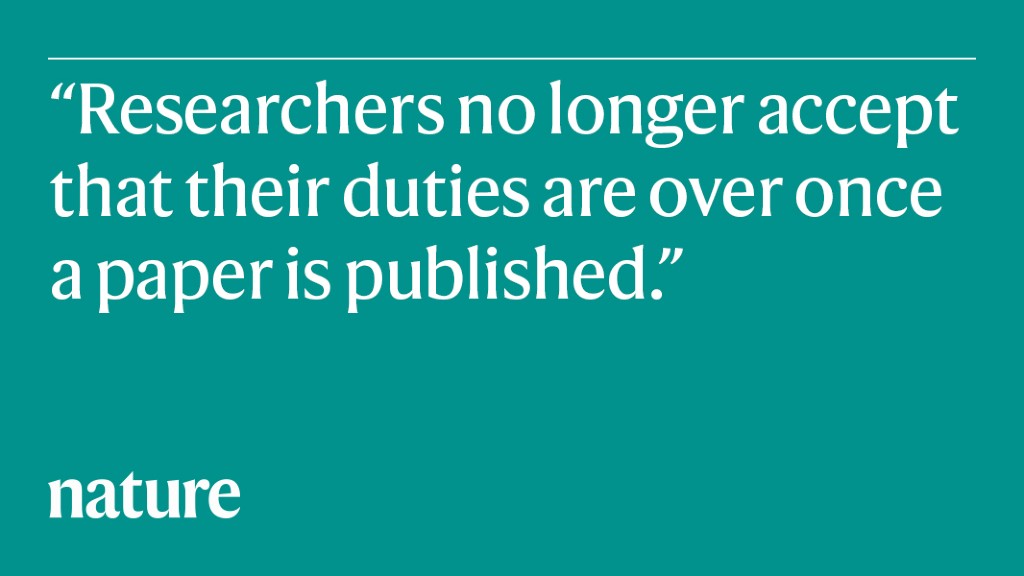A few years ago, one of my mentors was surprised when he realized he shared a name with a porn star. He wrote to Google to request that queries under his name not turn up racy images. Another adviser had learnt that a former junior colleague had added his name to a conference submission without his knowledge, presumably to enhance its prestige, and my adviser found himself accused of undisclosed conflicts of interest.
Such stories are common across academia — and are as likely to arise from malpractice as from mix-ups. Scholars’ names, work or both are used by crooked individuals or institutions to deceive others. The scope of the problem dismays me. I shiver when imagining my university’s research-integrity officer coming to me with a pile of buggy papers — that I’ve never seen before — bearing my name.
Funders, publishers and institutions all bear responsibility to craft policies that stymie scholarly abuse. But individual scholars have some power — and a duty — to do so, too. I propose a ‘hygiene routine’ that scientists should repeat regularly — much like getting a haircut or a dental check-up. The threat of detection and broader community awareness of abuse could shrink established predatory practices and nip emerging ones in the bud.
Every other month or so, I do my own scholarly check-up. These tasks not only protect my own reputation, but also discourage abuse in general. If researchers everywhere adopt such a habit, we can keep abuse from becoming rampant.
As part of my digital-hygiene routine, I search my own name and affiliation in an online search engine to make sure I’m not on editorial boards of predatory journals or conference committees I’ve never heard of. I check whether I have received unconsented acknowledgement, a form of authorship abuse, which ‘credits’ your support and contribution to a paper without your knowledge and suggests the work represents your views. If anything turns up, you can contact the publisher or the corresponding author of the study, copying in your own university administrators or research-integrity officers.
Another part is consulting your researcher profile on bibliographic databases, including Dimensions and Google Scholar. Better still, subscribe to alerts and contact Dimensions, Scopus or Web of Science if your work is attributed to another scientist with your name, or vice versa. Use citation alerts to correct misrepresentations of your results.
This monitoring will help you find opportunities, too. Liaise with researchers you’ve worked with. Telling your co-authors about who has cited your work (and why) can strengthen ties and revitalize idle collaborations. When members of my team saw researchers putting software we’d written to use, we updated it to screen for problematic papers and improved how it scanned for ‘tortured phrases’ — which are produced by paraphrasing software to conceal plagiarism — such as ‘p-esteem’ (instead of ‘p-value’).
Reviewing activities also demand care. When reviewing a paper, be aware of techniques to evade plagiarism detection and point them out to editors. In the ‘related work’ section, look for pasted strings of paragraphs that have been computationally modified to evade plagiarism detectors and mimic an original synthesis of ideas. Reject submissions with such content.
Part of your routine should be highlighting your pro bono, good-faith efforts in reviewing. How many reviewers have read a published paper and wondered whether the authors even saw their critiques that took hours? Sometimes they don’t: journal editors might not know how to address reviews, or be pressured to get papers published quickly.
To make your effort visible, add the relevant parts of your evaluation report to PubPeer. Post a comment (signed or not) stating that you had offered this criticism but never saw the authors’ rebuttal. This will demonstrate that the journal editors either did not deliver valuable comments or let them go unaddressed. Authors (or other readers) can then deliver a point-by-point public response, should they wish to. Perhaps researchers will find ways to consider these comments in meta-analyses, or manuscript editors could use them to get a sense of how articles published in their journals are perceived.
As a scholar, become aware and keep yourself informed of how scammers deceive editors, reviewers and authors. Skim through PubPeer and Retraction Watch. Stay alert for predatory publishers and their flattering schemes. When you do notice a problem in a publication, such as erroneous formulae, fabricated data or manipulated images, post a comment on PubPeer to notify the authors so that they can clarify the situation. This will help reviewers and authors to see the problems that routinely crop up at certain journals. Praise counts, too. If you realize an approach could work beyond the applications described, say so.
These check-ups aren’t cure-alls for predatory publishers, deceptive practices, unheeded reviews or simple mistakes. Think of it like cleaning up a beach: more litter will wash in, but the more that’s removed, the cleaner the beach is and the more pollution is discouraged.
Researchers no longer accept that their duties are over once a paper is published. If everyone monitors their corpus, a scourge of abuses will be squelched — and productive collaborations will rise in its place.
Competing Interests
The author declares no competing interests.






More News
I study artefacts left in prehistoric caves
How artificial intelligence is helping to identify global inequalities
Tackling ‘wicked’ problems calls for engineers with social responsibility